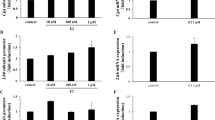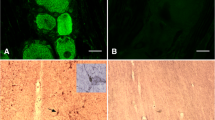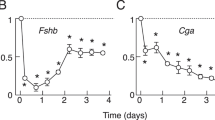Abstract
An immortal cell line (LβT-2) with characteristics of gonadotropes, such as LH-containing secretory granules, and LH release responsiveness to GnRH, was used to investigate the effect of GnRH stimulation on nitric oxide (NO) production. RT-PCR analysis showed that mouse nNOS mRNA was expressed in cultured LβT-2 cells. LβT-2 cells were treated with the calcium ionophore, A23187, and NO levels were measured as nitrite using the Griess assay. The data clearly showed that NO production was increased dose-dependently by A23187 treatment (0–10-5 M). Next, changes in the intracellular concentration of ionized calcium ([Ca2+]i) in LβT-2 cells induced by GnRH were analyzed by quantitative fluorescence microscopy, and [Ca2+]i was found to be increased markedly by GnRH treatment. In fact, exposure of LβT-2 cells to increasing concentrations of GnRH from 0 to 10-6 M was found to enhance NO production in a dose dependent manner, with maximal augmentation at 10-6 M. However, the stimulation of NO production by GnRH at this concentration was significantly attenuated by pretreatment with NG-nitro-L-arginine methyl ester hydrochloride (L-NAME), a NO synthase inhibitor.
Taken together, the present results suggest that GnRH treatment results in increased NO production in LβT-2 clonal gonadotropes, and intracellular calcium augmentation produced by GnRH may be participate in this process. Our findings also indicate that the LβT-2 cell line is a useful tool for in vitro studies of the autocrine and paracrine roles of NO in the anterior pituitary gland.
Similar content being viewed by others
References
Moncada S, Palmer RM, Higgs EA. Nitric oxide: Physiology, pathophysiology, and pharmacology. Pharmacol Rev 1991; 43:109–142.
Nathan C. Nitric oxide as a secretory product of mammalian cells. Faseb J 1992;6:3051–3064.
Palmer RM, Ashton DS, Moncada S. Vascular endothelial cells synthesize nitric oxide from L-arginine. Nature 1988; 333:664–666.
Palmer RM, Ferrige AG, Moncada S. Nitric oxide release accounts for the biological activity of endothelium-derived relaxing factor. Nature 1987;327:524–526.
Springall DR, Riveros-Moreno V, Buttery L, Suburo A, Bishop AE, Merrett M, Moncada S, Polak JM. Immunological detection of nitric oxide synthase(s) in human tissues using heterologous antibodies suggesting different isoforms. Histochemistry 1992;98:259–266.
Bredt DS, Hwang PM, Snyder SH. Localization of nitric oxide synthase indicating a neural role for nitric oxide. Nature 1990;347:768–770.
Ceccatelli S, Hulting AL, Zhang X, Gustafsson L, Villar M, Hokfelt T. Nitric oxide synthase in the rat anterior pituitary gland and the role of nitric oxide in regulation of luteinizing hormone secretion. Proc Natl Acad Sci USA 1993;90:11292–11296.
Kishimoto J, Tsuchiya T, Emson PC, Nakayama Y. Immobilization-induced stress activates neuronal nitric oxide synthase (nNOS) mRNA and protein in hypothalamic-pituitary-adrenal axis in rats. Brain Res 1996;720:159–171.
Reid IA. Role of nitric oxide in the regulation of renin and vasopressin secretion. Front Neuroendocrinol 1994;15:351–383.
Yamada K, Xu ZQ, Zhang X, Gustafsson L, Hulting AL, de Vente J, Steinbusch HW, Hokfelt T. Nitric oxide synthase and cGMP in the anterior pituitary gland: Effect of a GnRH antagonist and nitric oxide donors. NeuroEndocrinology 1997;65:147–156.
Duvilanski BH, Zambruno C, Seilicovich A, Pisera D, Lasaga M, Diaz MC, Belova N, Rettori V, McCann SM. Role of nitric oxide in control of prolactin release by the adenohypophysis. Proc Natl Acad Sci USA 1995;92:170–174.
Kato M. Involvement of nitric oxide in growth hormone (GH)-releasing hormone-induced GH secretion in rat pituitary cells. Endocrinology 1992;131:2133–2138.
Ceccatelli S. Expression and plasticity ofNOsynthase in the neuroendocrine system. Brain Res Bull1997;44:533–538.
Duvilanski BH, Zambruno C, Lasaga M, Pisera D, Seilicovich A. Role of nitric oxide/cyclic GMP pathway in the inhibitory effect of GABA and dopamine on prolactin release. J Neuroendocrinol 1996;8:909–913.
Tena-Sempere M, Pinilla L, Gonzalez D, Aguilar E. Involvement of endogenous nitric oxide in the control of pituitary responsiveness to different elicitors of growth hormone release in prepubertal rats. NeuroEndocrinology 1996;64:146–152.
Turgeon JL, Kimura Y, Waring DW, Mellon PL. Steroid and pulsatile gonadotropin-releasing hormone (GnRH) regulation of luteinizing hormone and GnRH receptor in a novel gonadotrope cell line. Mol Endocrinol 1996;10:439–450.
Thomas P, Mellon PL, Turgeon J, Waring DW. The LbT2 clonal gonadotrope: a model for single cell studies of endocrine cell secretion. Endocrinology 1996;137:2979–2989.
KatoM, Hoyland J, Sikdar SK, MasonWT. Imaging of intracellular calcium in rat anterior pituitary cells in response to growth hormone releasing factor. J Physiol 1992;447:171–189.
Grynkiewicz G, Poenie M, Tsien RY. A new generation of Ca21 indicators with greatly improved fluorescence properties. J Biol Chem 1985;260:3440–3450.
Furchgott RF, Zawadzki JV. The obligatory role of endothelial cells in the relaxation of arterial smooth muscle by acetylcholine. Nature 1980;288:373–376.
Murad F, Ishii K, Forstermann U, Gorsky L, Kerwin JF Jr, Pollock J, Heller M. EDRF is an intracellular second messenger and autacoid to regulate cyclic GMP synthesis in many cells. Adv Second Messenger Phosphoprotein Res 1990;24:441–448.
Bredt DS, Snyder SH. Nitric oxide, a novel neuronal messenger. Neuron 1992;8:3–11.
Snyder SH. Nitric oxide: First in a new class of neurotransmitters. Science 1992;257:494–496.
McCann SM, Karanth S, Kimura M, Yu WH, Rettori V. The role of nitric oxide (NO) in control of hypothalamic-pituitary function [In Process Citation]. Rev Bras Biol 1996;1: 105–112.
Rettori V, Kamat A, McCann SM. Nitric oxide mediates the stimulation of luteinizing-hormone releasing hormone release induced by glutamic acid in vitro. Brain Res Bull 1994;33:501–503.
Rettori V, Belova N, Dees WL, Nyberg CL, Gimeno M, McCann SM. Role of nitric oxide in the control of luteinizing hormone-releasing hormone release in vivo and in vitro. Proc Natl Acad Sci USA 1993;90:10130–10134.
Okere CO, Murata E, Murata T, Takahashi S, Okutani F, Higuchi T. Parturition upregulates nitric oxide synthase activity in the rat anterior pituitary gland. Neuroreport 1997;8:817–821.
Hashimoto K, Nishioka T, Tojo C, Takao T.Nitric oxide plays no role in ACTH release induced by interleukin-1 beta, corticotropin-releasing hormone, arginine vasopressin and phorbol myristate acetate in rat pituitary cell cultures. Endocr J 1995;42:435–439.
Lloyd RV, Jin L, Qian X, Zhang S, Scheithauer BW. Nitric oxide synthase in the human pituitary gland. Am J Pathol 1995;146:86–94.
Author information
Authors and Affiliations
Rights and permissions
About this article
Cite this article
Chen, L., Sakai, T., Sakamoto, S. et al. Direct Evidence of Gonadotropin-Releasing Hormone (GnRH)-Stimulated Nitric Oxide Production in the LβT-2 Clonal Gonadotropes. Pituitary 2, 191–196 (1999). https://doi.org/10.1023/A:1009988808338
Issue Date:
DOI: https://doi.org/10.1023/A:1009988808338




